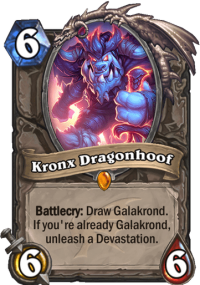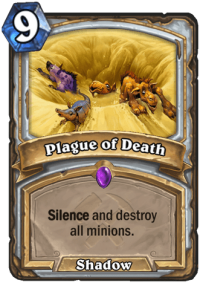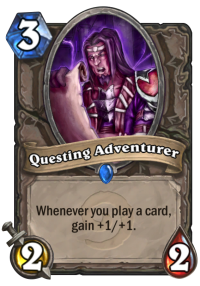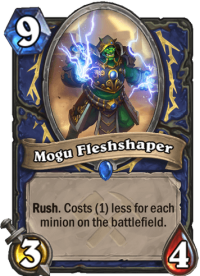Descent of Dragons is almost here, and the good news for free-to-play players is that everyone will get all five variants of Galakrond for free! Furthermore, everyone will also get two copies of the Neutral Galakrond synergy card Shield of Galakrond for free, so you can get to Invoking your Galakrond right away.
Is it really that easy? Almost, yes. You will want to do a lot of Invoking in any Galakrond deck, so you will want all eight Invoke cards available for each deck. Luckily, the other Neutral Invoke card, Devoted Maniac, is a common, and the class Invoke cards are a common and a rare for each class. Crafting two copies of each costs you 80 dust for the Neutrals and then 280 dust for each class.

You can add more Galakrond synergy to your deck with the Neutral card Kronx Dragonhoof, which unfortunately is a Legendary, and the Galakrond class synergy cards for each class, which are all Epics. This will cost a bit more, and most of those Epics are pretty good too, but you can build functional Galakrond decks without them as well.
People often ask me to build budget decks right at the start of an expansion. So far, I have always declined. Dust is a precious resource for a budget player, and truly competitive budget decks can only be built for a somewhat stable meta: you need to exploit any openings in the meta to succeed. Budget decks also need a lot of testing in order to find every edge you can. Consequently, I have played to Legend multiple times with decks that cost around 1500 dust.
However, this offer of five free Galakronds is just too good to pass up. Therefore, I have attempted to theorycraft viable Galakrond budget decks that you can take to the ladder right when the expansion launches. I have built one version with all the Galakrond synergy cards available, and another one that skips the Epics and Kronx Dragonhoof for each class. Sometimes, the difference is just those three cards, and sometimes the decks need more work because of the missing pieces.
The key to building budget decks is to try to find a niche where you can succeed with the cards you have. If you just cut a couple of good cards from a meta deck, then you have an inferior version of the meta deck. That is not good enough. You want to find a different angle that allows you to have a higher win rate than a culled meta deck, even if you cannot build your deck to match the full version in performance. This is what I have attempted here as well, although without knowing the meta, the task is admittedly Sisyphean. The best I can hope for is that you can find some fun games with your free Galakronds without the need to spend dust – the good versions will come later.
Priest
Galakrond, the Unspeakable actually gives Priest a budget control win condition: Galakrond Priest creates tons of random Priest minions, so your goal is simply to survive and grind out the opponent with your never-ending army. The last time I was able to build a budget control deck was when Uther of the Ebon Blade was in Standard format, so I’m obviously really excited about the prospect of actually playing control on a budget.

However, there are many obstacles on the way. The first issue is the question of the overall viability of a super-grindy control deck in the current meta. Hearthstone is a tempo game and does not favor control as a win condition, especially so when that control does not take you above 30 Health, so you remain susceptible to damage-based combos. The second is the question of whether Priest can do it on a budget: Paladin has all of its removal within the reach of budget players, it just lacks a budget win condition, but Priest’s most powerful removal tool, Plague of Death, is an Epic. Furthermore, Galakrond Priest loves Princess Talanji, because she can give you a huge tempo swing by summoning all the random Priest minions from your hand at once. As a Legendary minion, she is out of reach of a budget player.
Despite these obstacles, there is some hope. Breath of the Infinite, Mass Hysteria, and Chronobreaker provide even a Budget Priest with some area-of-effect damage, and Priest’s single-target removal is both plentiful and cheap.
The first version of the deck uses Kronx Dragonhoof and Fate Weaver: Kronx can be invaluable, not just because of the Devastation ability, but also as a tutor that draws Galakrond. Galakrond Priest needs to start grinding that value, and if Galakrond is at the bottom, things look dire. Fate Weaver can discount your randomly-generated Priest minions to make them easier to get on the board.
For the full budget version, I played around with two ideas: either keeping the Dragon package and just replacing Fate Weaver, or building a more draw-heavy list with Wild Pyromancers and Acolyte of Pains. While the draw-heavy list should be better at finding Galakrond, I’m concerned that it could run into fatigue too quickly and be unable to survive long enough to grind out the game. Therefore, I ended up with the Dragon list for now, adding in a pair of Twilight Drakes as Dragon activators and threats.
Rogue

I love what Galakrond Rogue can offer, but I also dislike building it on a budget. Rogue’s Galakrond generates additional Lackeys, and that is something you would really want to take advantage of with Heistbaron Togwaggle. Throw in Flik Skyshiv and a pair of Shadowsteps and we’re really talking. It is difficult to find a completely new vantage point for the deck, so the full-cost version just seems superior to anything that can be built on a budget. The traditional way to build a Budget Rogue is to build it as a faster variant of the meta deck so that you can go under them, but the Galakrond package does not easily allow you to do that.
All is not lost, however, because there is always Questing Adventurer. In this semi-budget build, Questing Adventurer is your main win condition with Hench-Clan Thug providing some much-needed emotional support. Everything in the deck is about making your Adventurer huge from Bloodsail Flybooter giving you extra token cards to Umbral Skulker bringing in a bunch of Coins. There are still some ways for you to exploit Lackey synergy on a budget thanks to Faceless Corruptor happily devouring some of those tokens to create more 5/4 Rush minions.
In Rogue, going from semi-budget to full budget brings about a considerable change. The only viable way to build a fully budget Rogue deck at the moment is to use the burgle package: Dragon's Hoard, Underbelly Fence, Blink Fox, Hench-Clan Burglar, and Vendetta are all added to the deck to control the tempo of the game.
You have fewer tools to build big Questing Adventurers, but they still remain your main win condition, because better ones are not available. At least you have a chance to win big with random cards. You sometimes have to take chances when playing on a budget, but between a bunch of good tempo cards, a reasonable win condition with Questing Adventurers, and the chance to win the randomness lottery, this deck can still get the job done.
Shaman
I ultimately opted to build three variants of Shaman, because access to key cards can really change how you want to build your deck for the class.

There are similarities between the decks, of course. Galakrond, the Tempest provides you with an endless stream of Rush tokens, and all the decks are variants of the token archetype, so Bloodlust is a win condition for every deck. Mogu Fleshshaper and Mutate remain too good to skip, especially with the major buff to them from the great eight-mana minions from the new expansion, such as Deathwing, Mad Aspect, and Corrupt Elementalist providing another potential target for Mutate.
The most expensive variant includes Thunderhead, which is a key card that enables Overload-based decks. Sure, you can use Likkim and Surging Tempest on a budget, but then you’re just playing a gimped version of the deck. Thunderhead makes the Overload Shaman, and without it, you should not go for the Overload synergies at all.
It is possible that an Overload Shaman deck without Galakrond turns out to be the best Shaman deck in Descent of Dragons, but a Galakrond variant does not look bad at all, either. Between the tokens generated by Thunderhead and your Invokes, and the amazing Dragon's Pack, this deck can generate a huge number of threats, all of which have to be answered so that a simple Bloodlust cannot end the game.
Sure, if you can afford Vessina and Shudderwock, they can be impressive additions, but the deck is fast without them, perhaps even faster than with them.
If you don’t have Thunderhead, Murlocs are the proper way to flood the board. This is a good example of how missing just one card can cause a lot of changes to a deck: almost all the Overload cards are gone with only Sludge Slurper (a Murloc) and Storm's Wrath remaining. Of course, Galakrond is still there, as are the Bloodlusts, Mogu Fleshshapers, and Mutates. With this variant, Underbelly Angler takes care of your refills with Galakrond providing Rush support. This variant leans slightly harder into Galakrond, too: Shaman can skip some Invoke cards thanks to the double Invoke from Corrupt Elementalist, but here all the Invoke cards are in use.
Finally, if you do not have Kronx Dragonhoof and Dragon's Pack, you want to lean harder into Murlocs. Shield of Galakrond is gone from this variant to make more space for Murlocs. This is really a hybrid Galakrond-Murloc deck that can win with a pure Murloc gameplan, but that can also make use of Galakrond as needed.
Warlock
For Warlock, I am not yet fully convinced by the Epic Galakrond synergy card, Veiled Worshipper. Warlock is already good at drawing cards, and having a mid-sized minion with no immediate effect in a Zoo list seems questionable. The more midrange your deck, the more potential it has, but I’d wait for some early results before crafting it. It is really meant to add to your card draw after you have become Galakrond and lost your ability to draw extra cards, but I am not sure whether it’s worth it.
Therefore, this semi-budget Warlock deck only adds Kronx Dragonhoof as compared to the fully budget list.
Other than that, both lists are the same. You have infinite tokens from Warlock Galakrond and its Invoke cards, so you want to use as many effects that benefit from tokens as possible: Grim Rally, Dire Wolf Alpha, Knife Juggler. EVIL Genius, and Faceless Corruptor all enable you to get the most out of your tokens.
If I were to build a more expensive deck, I would look into reducing Lackey use in favor of some power plays such as Sea Giants, but on a budget Sinister Deal and EVIL Recruiter are still worth their salt: you want to end games quickly when playing on a budget.
Warrior
Galakrond Warrior is an aggro deck or a midrange deck. Ideally, you draw some big Charge minions with Galakrond and roll over the opponent with them, Inner Rage, and Bloodsworn Mercenary. Well, that’s a bit of a problem for a budget deck right there, as Bloodsworn Mercenary is an Epic and Leeroy Jenkins and Grommash Hellscream, two of the best Charge minions, are Legendary cards.
Therefore, a new plan is needed. Galakrond becomes a refill and buff, while the rest of the deck adopts a more aggressive tone with Rampage and Frothing Berserker taking on key roles. It is still possible to draw Kor'kron Elite with Galakrond, but with no Bloodsworn Mercenary to copy it with, it is not quite as devastating.
The semi-budget version has a lot of value from Kronx Dragonhoof and Scion of Ruin, which is another spectacular minion to draw with Galakrond. Hitting face and rushing down the opponent’s minions can still get the job done.
The full budget version faces more challenges. With less value available, it adds a second copy of Cruel Taskmaster to add some speed to the deck, and two copies of Southsea Deckhand to improve the odds of drawing a Charge minion with Galakrond. Nonetheless, Rampage and Frothing Berserker have a lot of work to do to find the wins with this variant.
Good luck, have fun
I still don’t like to theorycraft budget decks. Spending all of your dust on a deck that does not deliver is terrible, and I always aim to build budget decks of the highest quality. That said, these budget Galakrond decks use a lot of cards that you hopefully already own because they have been used in the top budget decks of their respective classes, and crafting the Invoke cards is a necessary investment to use Galakrond at all. Hopefully, you will find them useful to go on a Galakrond adventure right at the start of the expansion!






















































































Remember there were changes to how Echo works. Echo cards can no longer be reduced to 0 mana. SN1P-SN4P, Glinda Crowskin and Sound the Bells were changed! We can get a full Dust refund until December 19. Hope this get people extra dust for the new expansion!
I absolutely love these decks, great work for getting such a detailed guide out so early into the expansion!
From the full-budget lists, i.e the ones without Kronx and the class epics, which deck would you predict will see the most success?
I understand this is a difficult question to answer, as the meta has yet to be determined. On a similar note, would you recommend I wait until the meta has settled before picking a deck to craft, or are these relatively safe crafts right now?
There are no really safe crafts yet. Sure, if you will play with Galakrond, you want some synergy cards, and there are some cards like Faceless Corruptor that are really having a major impact already, but you typically want to craft decks and not individual cards, so it is hard to say which cards will be in decks you want to play.
Of these decks, I’m expecting Warlock and Rogue to work reasonably well, but I have not yet had a chance to test them. Shaman should also be fine, although missing out on Thunderhead can be a big deal. I played a bunch of Priest today, but it might be too slow against Pirate Warrior, I’ll see if I can make it faster.
Thanks for the speedy reply!
I’ll be sure to stay tuned to your YouTube channel to see where the meta goes.
Without being too much of a fanboy, you’ve been my favourite Hearthstone YouTuber since I discovered your channel a year ago, so I’m extremely glad to see you sharing your expertise on this site!
Many thanks Old Guardian! These decks are perfect to test in Day 1. I’ll play Shaman for sure